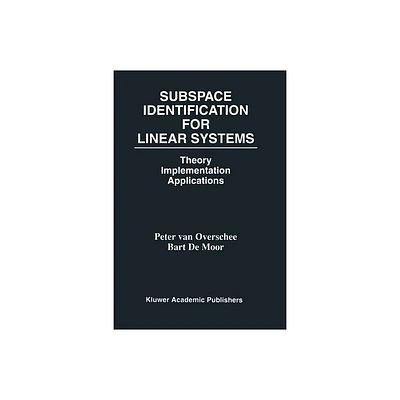Home
Subspace Identification for Linear Systems: Theory - Implementation - Applications
Loading Inventory...
Barnes and Noble
Subspace Identification for Linear Systems: Theory - Implementation - Applications
Current price: $139.99


Barnes and Noble
Subspace Identification for Linear Systems: Theory - Implementation - Applications
Current price: $139.99
Loading Inventory...
Size: OS
*Product Information may vary - to confirm product availability, pricing, and additional information please contact Barnes and Noble
Subspace Identification for Linear Systems focuses on the theory, implementation and applications of subspace identification algorithms for linear time-invariant finite- dimensional dynamical systems. These algorithms allow for a fast, straightforward and accurate determination of linear multivariable models from measured input-output data. The theory of subspace identification algorithms is presented in detail. Several chapters are devoted to deterministic, shastic and combined deterministic-shastic subspace identification algorithms. For each case, the geometric properties are stated in a main 'subspace' Theorem. Relations to existing algorithms and literature are explored, as are the interconnections between different subspace algorithms. The subspace identification theory is linked to the theory of frequency weighted model reduction, which leads to new interpretations and insights. The implementation of subspace identification algorithms is discussed in terms of the robust and computationally efficient RQ and singular value decompositions, which are well-established algorithms from numerical linear algebra. The algorithms are implemented in combination with a whole set of classical identification algorithms, processing and validation tools in Xmath's ISID, a commercially available graphical user interface toolbox. The basic subspace algorithms in the book are also implemented in a set of Matlab files accompanying the book. An application of ISID to an industrial glass tube manufacturing process is presented in detail, illustrating the power and user-friendliness of the subspace identification algorithms and of their implementation in ISID. The identified model allows for an optimal control of the process, leading to a significant enhancement of the production quality. The applicability of subspace identification algorithms in industry is further illustrated with theapplication of the Matlab files to ten practical problems. Since all necessary data and Matlab files are included, the reader can easily step through these applications, and thus get more insight in the algorithms. Subspace Identification for Linear Systems is an important reference for all researchers in system theory, control theory, signal processing, automization, mechatronics, chemical, electrical, mechanical and aeronautical engineering.


















